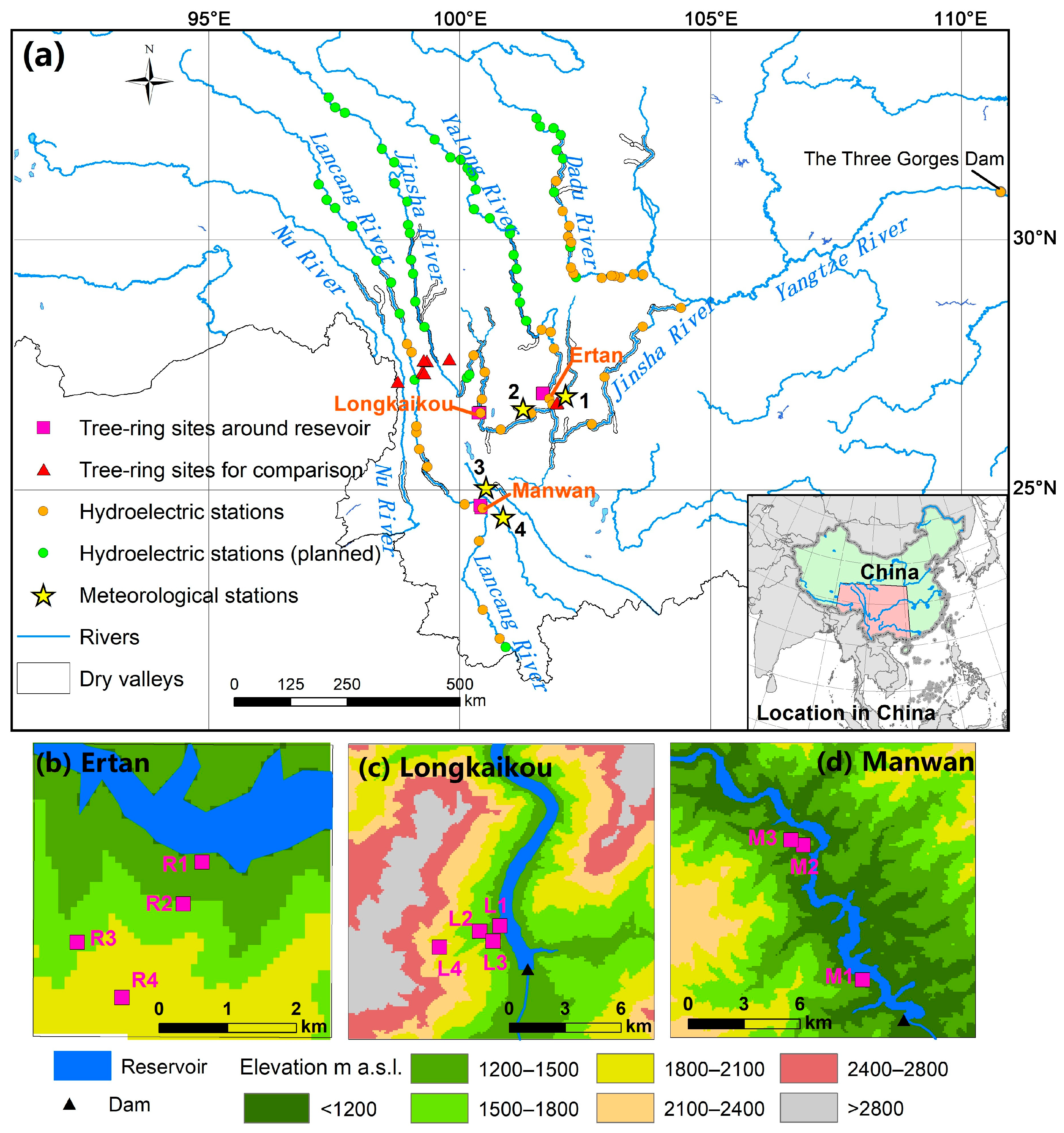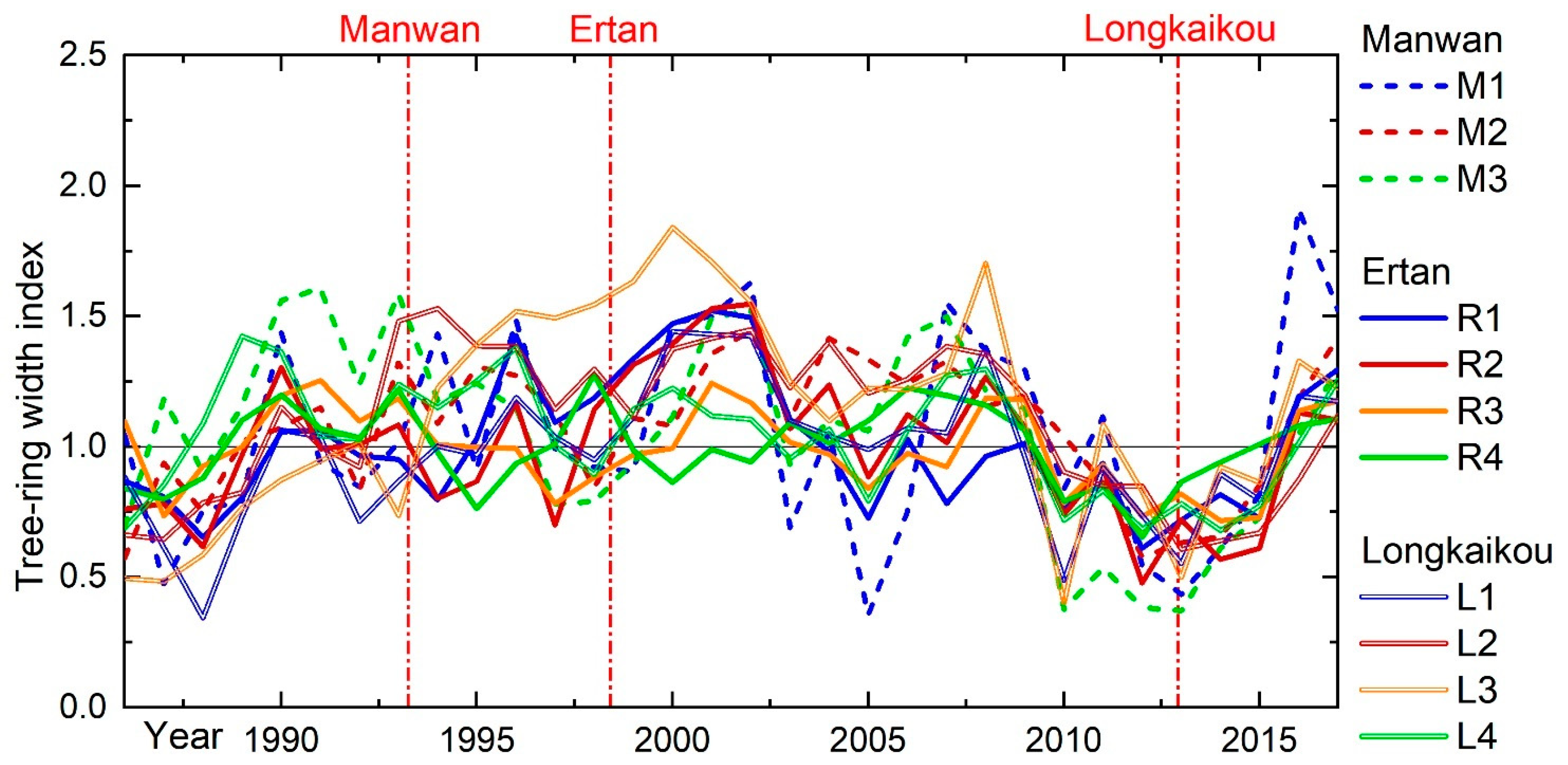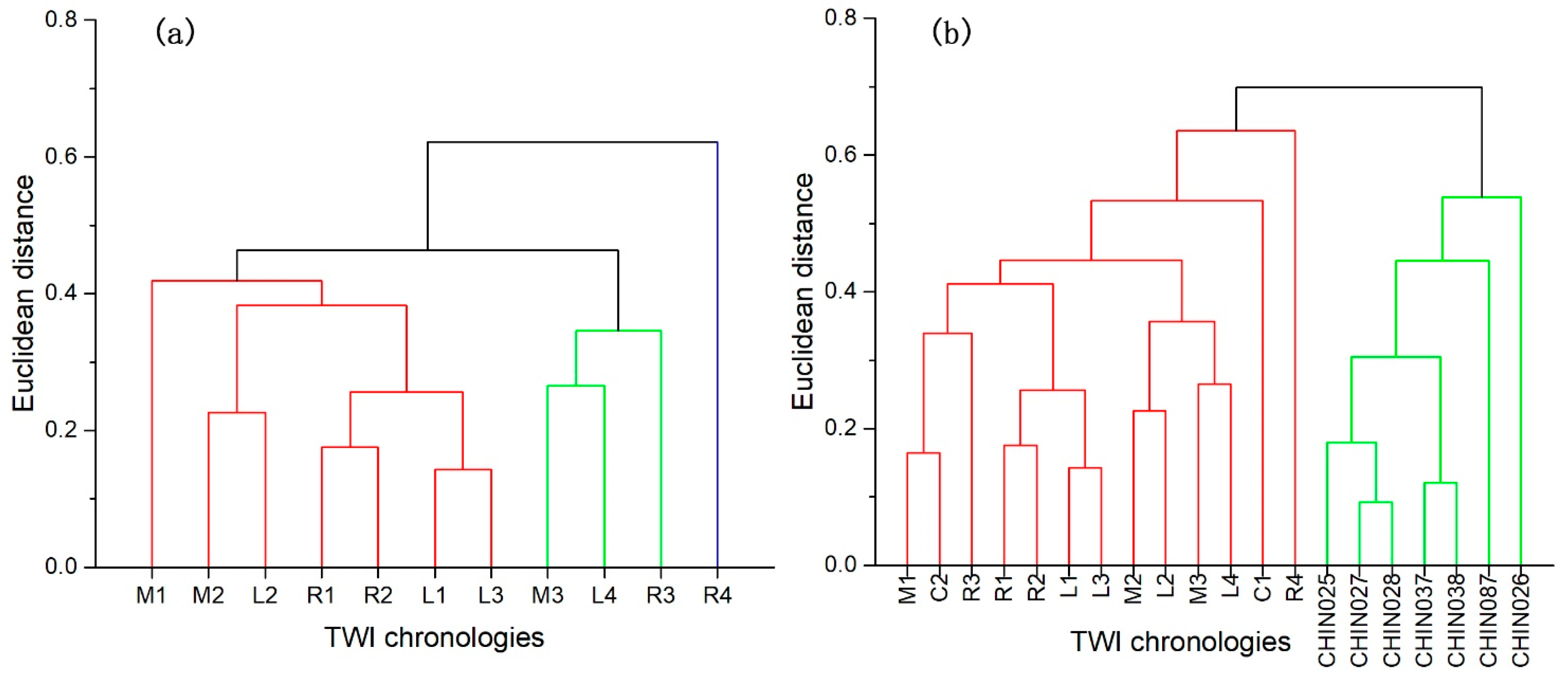Tree Radial Growth Responses to Climate and Reservoir Impoundment in Valleys in Southwestern China
Abstract
:1. Introduction
2. Materials and Methods
2.1. Overviews of Tree-Ring Sites and Hydroelectric Reservoirs
2.2. Tree-Ring Sampling and Measurements
2.3. Meteorological Data and the Responses of Tree Growth to the Regional Climate
2.4. Influences of Reservoir Impoundment on Tree Growth
3. Results
3.1. Characteristics of Tree Rings
3.2. Radial Growth Responses to the Regional Climate
3.3. Changes in Tree-Ring Width Index after Reservoir Impounding
4. Discussion
4.1. Elevation Effect of Responses to the Regional Climate
4.2. The Responses of Radial Growth to Reservoir Impoundment
4.3. Study Limitations and Future Work
5. Conclusions
Supplementary Materials
Author Contributions
Funding
Data Availability Statement
Conflicts of Interest
References
- Piao, S.; Wang, X.; Park, T.; Chen, C.; Lian, X.; He, Y.; Bjerke, J.W.; Chen, A.; Ciais, P.; Tømmervik, H. Characteristics, drivers and feedbacks of global greening. Nat. Rev. Earth Environ. 2020, 1, 14–27. [Google Scholar] [CrossRef]
- Yang, H.; Munson, S.M.; Huntingford, C.; Carvalhais, N.; Knapp, A.K.; Li, X.; Peñuelas, J.; Zscheischler, J.; Chen, A. The detection and attribution of extreme reductions in vegetation growth across the global land surface. Glob. Change Biol. 2023, 29, 2351–2362. [Google Scholar] [CrossRef] [PubMed]
- Gernaat, D.E.; de Boer, H.S.; Daioglou, V.; Yalew, S.G.; Müller, C.; van Vuuren, D.P. Climate change impacts on renewable energy supply. Nat. Clim. Change 2021, 11, 119–125. [Google Scholar] [CrossRef]
- Groenendijk, P.; Sass-Klaassen, U.; Bongers, F.; Zuidema, P.A. Potential of tree-ring analysis in a wet tropical forest: A case study on 22 commercial tree species in Central Africa. For. Ecol. Manag. 2014, 323, 65–78. [Google Scholar] [CrossRef]
- Jiao, W.; Wang, L.; Smith, W.K.; Chang, Q.; Wang, H.; D’Odorico, P. Observed increasing water constraint on vegetation growth over the last three decades. Nat. Commun. 2021, 12, 3777. [Google Scholar] [CrossRef] [PubMed]
- Dong, B.G.; Yu, Y.; Pereira, P. Non-growing season drought legacy effects on vegetation growth in southwestern China. Sci. Total Environ. 2022, 846, 157334. [Google Scholar] [CrossRef] [PubMed]
- Xiao, L.; Wang, J.; Wang, B.; Jiang, H. China’s hydropower resources and development. Sustainability 2023, 15, 3940. [Google Scholar] [CrossRef]
- Fan, Z.X.; Brauning, A.; Yang, B.; Cao, K.F. Tree ring density-based summer temperature reconstruction for the central Hengduan Mountains in southern China. Glob. Planet. Change 2009, 65, 1–11. [Google Scholar] [CrossRef]
- Guo, G.; Li, Z.-S.; Zhang, Q.-B.; Ma, K.-P.; Mu, C. Dendroclimatological studies of Picea likiangensis and Tsuga dumosa in Lijiang, China. IAWA J. 2009, 30, 435–441. [Google Scholar] [CrossRef]
- Shi, S.; Li, J.; Shi, J.; Zhao, Y.; Huang, G. Three centuries of winter temperature change on the southeastern Tibetan Plateau and its relationship with the Atlantic Multidecadal Oscillation. Clim. Dyn. 2017, 49, 1305–1319. [Google Scholar] [CrossRef]
- Fan, Z.-X.; Bräuning, A.; Cao, K.-F. Annual temperature reconstruction in the central Hengduan Mountains, China, as deduced from tree rings. Dendrochronologia 2008, 26, 97–107. [Google Scholar] [CrossRef]
- Li, T.; Li, J. A 564-year annual minimum temperature reconstruction for the east central Tibetan Plateau from tree rings. Glob. Planet. Change 2017, 157, 165–173. [Google Scholar] [CrossRef]
- Jiang, Y.-M.; Li, Z.-S.; Fan, Z.-X. Tree-ring based February–April relative humidity reconstruction since AD 1695 in the Gaoligong Mountains, southeastern Tibetan Plateau. Asian Geogr. 2017, 34, 59–70. [Google Scholar] [CrossRef]
- Yin, D.; Xu, D.; Tian, K.; Xiao, D.; Zhang, W.; Sun, D.; Sun, H.; Zhang, Y. Radial Growth Response of Abies georgei to Climate at the Upper Timberlines in Central Hengduan Mountains, Southwestern China. Forests 2018, 9, 606. [Google Scholar] [CrossRef]
- Li, J.; Li, J.; Li, T.; Au, T.F. Tree growth divergence from winter temperature in the Gongga Mountains, southeastern Tibetan Plateau. Asian Geogr. 2019, 37, 1–15. [Google Scholar] [CrossRef]
- Keyimu, M.; Li, Z.; Zhang, G.; Fan, Z.; Wang, X.; Fu, B. Tree ring–based minimum temperature reconstruction in the central Hengduan Mountains, China. Theor. Appl. Climatol. 2020, 141, 359–370. [Google Scholar] [CrossRef]
- Yuan, S.; Jiang, Y.; Zhao, Z.; Cui, M.; Shi, D.; Wang, S.; Kang, M. Different trends and divergent responses to climate factors in the radial growth of Abies georgei along elevations in the central Hengduan Mountains. Dendrochronologia 2023, 80, 126114. [Google Scholar] [CrossRef]
- Yang, R.-Q.; Zhao, F.; Fan, Z.-X.; Panthi, S.; Fu, P.-L.; Bräuning, A.; Griessinger, J.; Li, Z.-S. Long-term growth trends of Abies delavayi and its physiological responses to a warming climate in the Cangshan Mountains, southwestern China. For. Ecol. Manag. 2022, 505, 119943. [Google Scholar] [CrossRef]
- Fan, Z.-X.; Bräuning, A.; Tian, Q.-H.; Yang, B.; Cao, K.-F. Tree ring recorded May–August temperature variations since AD 1585 in the Gaoligong Mountains, southeastern Tibetan Plateau. Palaeogeogr. Palaeoclimatol. Palaeoecol. 2010, 296, 94–102. [Google Scholar] [CrossRef]
- Bräuning, A. Summer temperature and summer monsoon history on the Tibetan plateau during the last 400 years recorded by tree rings. Geophys. Res. Lett. 2004, 31, L24024. [Google Scholar] [CrossRef]
- Duan, J.; Zhang, Q.B. A 449 year warm season temperature reconstruction in the southeastern Tibetan Plateau and its relation to solar activity. J. Geophys. Res. Atmos. 2014, 119, 11578–11592. [Google Scholar] [CrossRef]
- Li, Z.S.; Liu, G.H.; Gong, L.; Wang, M.; Wang, X.C. Tree ring-based temperature reconstruction over the past 186 years for the Miyaluo Natural Reserve, western Sichuan Province of China. Theor. Appl. Climatol. 2015, 120, 495–506. [Google Scholar] [CrossRef]
- Li, Z.; Liu, G.; Wu, X.; Wang, X. Tree-ring-based temperature reconstruction for the Wolong Natural Reserve, western Sichuan Plateau of China. Int. J. Climatol. 2015, 35, 3296–3307. [Google Scholar] [CrossRef]
- Yue, H.; Li, J.; Xie, S.; Chen, H.; Tian, K.; Sun, M.; Zhang, D.; Zhang, Y. Relationships between Climate Variability and Radial Growth of Larix potaninii at the Upper Altitudinal Limit in Central Hengduan Mountain, Southwestern China. Forests 2023, 14, 1790. [Google Scholar] [CrossRef]
- Zhang, Y.; Cao, R.; Yin, J.; Tian, K.; Xiao, D.; Zhang, W.; Yin, D. Radial growth response of major conifers to climate change on Haba Snow Mountain, Southwestern China. Dendrochronologia 2020, 60, 125682. [Google Scholar] [CrossRef]
- Fan, Z.-X.; Bräuning, A.; Cao, K.-F.; Zhu, S.-D. Growth–climate responses of high-elevation conifers in the central Hengduan Mountains, southwestern China. For. Ecol. Manag. 2009, 258, 306–313. [Google Scholar] [CrossRef]
- Zhang, Y.; Yin, D.; Tian, K.; Zhang, W.; He, R.; He, W.; Sun, J.; Liu, Z. Radial growth responses of Picea likiangensis to climate variabilities at different altitudes in Yulong Snow Mountain, southwest China. Chin. J. Plant Ecol. 2018, 42, 629–639. [Google Scholar]
- Guo, M.-M.; Zhang, Y.-D.; Wang, X.-C.; Liu, S.-R. Difference in responses of major tree species growth to climate in the Miyaluo Mountains, western Sichuan, China. Chin. J. Appl. Ecol. 2015, 26, 2237–2243. [Google Scholar]
- Sun, L.; Cai, Y.; Zhou, Y.; Shi, S.; Zhao, Y.; Gunnarson, B.E.; Jaramillo, F. Radial growth responses to climate of Pinus yunnanensis at low elevations of the Hengduan Mountains, China. Forests 2020, 11, 1066. [Google Scholar] [CrossRef]
- Shen, J.; Li, Z.; Gao, C.; Li, S.; Huang, X.; Lang, X.; Su, J. Radial growth response of Pinus yunnanensis to rising temperature and drought stress on the Yunnan Plateau, southwestern China. For. Ecol. Manag. 2020, 474, 118357. [Google Scholar] [CrossRef]
- Integrated Scientific Expeditional Team to Qinghai-Tibet Plateau, Chinese Academy of Sciences. The Dry Valleys of the Hengduan Mountains Region; Science Press: Beijing, China, 1992. [Google Scholar]
- Guo, Q.K.; Shan, Z.J.; Lu, W.; Qin, W.; Yin, Z.; Xu, H.C. Fingerprinting sediment sources in two typical watersheds in the dry-hot valleys of Southwest China: The role of gully and orchard land. Catena 2023, 233, 107479. [Google Scholar] [CrossRef]
- Grelsson, G. Radial stem growth of coniferous trees near Swedish reservoirs. Regul. Rivers Res. Manag. 1988, 2, 535–545. [Google Scholar] [CrossRef]
- Sun, L.; Jaramillo, F.; Cai, Y.; Zhou, Y.; Shi, S.; Zhao, Y.; Wang, W.; Yang, W.; Yi, Y.; Yang, Z.; et al. Exploring the influence of reservoir impoundment on surrounding tree growth. Adv. Water Resour. 2021, 153, 103946. [Google Scholar] [CrossRef]
- Czyżyk, K. Radial growth response of Scots Pine (Pinus sylvestris L.) after increasing the availability of water resources. Forests 2021, 12, 1053. [Google Scholar] [CrossRef]
- Zhirnova, D.; Belokopytova, L.; Meko, D.; Babushkina, E.; Vaganov, E. Climate change and tree growth in the Khakass-Minusinsk Depression (South Siberia) impacted by large water reservoirs. Sci. Rep. 2021, 11, 14266. [Google Scholar] [CrossRef]
- Tremblay, M.; Begin, Y. The response of black spruce to the climatic influence of Robert-Bourassa Reservoir in northern Quebec. Ecoscience 2000, 7, 228–236. [Google Scholar] [CrossRef]
- Mazza, G.; Becagli, C.; Proietti, R.; Corona, P. Climatic and anthropogenic influence on tree-ring growth in riparian lake forest ecosystems under contrasting disturbance regimes. Agric. For. Meteorol. 2020, 291, 108036. [Google Scholar] [CrossRef]
- Liang, Y.N.; Cai, Y.P.; Wang, X.; Li, C.H.; Liu, Q. Projected climate impacts of large artificial reservoir impoundment in Yalong River Basin of southwestern China. J. Hydrometeorol. 2021, 22, 2179–2191. [Google Scholar] [CrossRef]
- Xu, G.; Liu, X.; Zhang, Q.; Zhang, Q.; Hudson, A.; Trouet, V. Century-scale temperature variability and onset of industrial-era warming in the Eastern Tibetan Plateau. Clim. Dyn. 2019, 53, 4569–4590. [Google Scholar] [CrossRef]
- Xing, Y.; Ree, R.H. Uplift-driven diversification in the Hengduan Mountains, a temperate biodiversity hotspot. Proc. Natl. Acad. Sci. USA 2017, 114, E3444–E3451. [Google Scholar] [CrossRef]
- Zhao, Y.J.; Gong, X. Diversity and conservation of plant species in dry valleys, southwest China. Biodivers. Conserv. 2015, 24, 2611–2623. [Google Scholar] [CrossRef]
- Wang, S.W.; Sui, X.P.; Liu, Y.; Gu, H.; Xu, B.; Xia, Q. Prediction and interpretation of the deformation behaviour of high arch dams based on a measured temperature field. J. Civ. Struct. Health Monit. 2023, 13, 661–675. [Google Scholar] [CrossRef]
- Wu, X.J.; Wang, L.C.; Cao, Q.; Niu, Z.G.; Dai, X. Regional climate change and possible causes over the Three Gorges Reservoir Area. Sci. Total Environ. 2023, 903, 166263. [Google Scholar] [CrossRef] [PubMed]
- Ren, Y.Y.; Xia, L.; Wang, Y.H. Forecasting China’s hydropower generation using a novel seasonal optimized multivariate grey model. Technol. Forecast. Soc. Change 2023, 194, 122677. [Google Scholar] [CrossRef]
- National Energy Administration. The 13th Five-Year Plan for the Development of Hydroelectricity; National Energy Administration: Beijing, China, 2016.
- Ho, M.; Lall, U.; Allaire, M.; Devineni, N.; Kwon, H.H.; Pal, I.; Raff, D.; Wegner, D. The future role of dams in the United States of America. Water Resour. Res. 2017, 53, 982–998. [Google Scholar] [CrossRef]
- Tang, G.; Qi, C. Dedrochronology (South China Version), 3rd ed.; China Forestry Publishing House: Beijing, China, 2015. [Google Scholar]
- Wigley, T.M.L.; Briffa, K.R.; Jones, P.D. On the average value of correlated time-series, with applications in dendroclimatology and hydrometeorology. J. Clim. Appl. Meteorol. 1984, 23, 201–213. [Google Scholar] [CrossRef]
- Sun, L.; Cai, Y.; Yang, W.; Yi, Y.; Yang, Z. Climatic variations within the dry valleys in southwestern China and the influences of artificial reservoirs. Clim. Change 2019, 155, 111–125. [Google Scholar] [CrossRef]
- Zhang, M.; He, J.; Wang, B.; Wang, S.; Li, S.; Liu, W.; Ma, X. Extreme drought changes in Southwest China from 1960 to 2009. J. Geogr. Sci. 2013, 23, 3–16. [Google Scholar] [CrossRef]
- Zong, H.; Sun, J.-R.; Zhou, L.; Bao, F.; Zheng, X.-Z. Effect of altitude and climatic parameters on shrub-meadow community composition and diversity in the dry valley region of the eastern Hengduan Mountains, China. J. Mt. Sci. 2022, 19, 1139–1155. [Google Scholar] [CrossRef]
- Yin, D.C.; Gou, X.H.; Yang, H.J.; Wang, K.; Liu, J.; Zhang, Y.R.; Gao, L.L. Elevation-dependent tree growth response to recent warming and drought on eastern Tibetan Plateau. Clim. Change 2023, 176, 77. [Google Scholar] [CrossRef]





| M1 | M2 | M3 | R1 | R2 | R3 | R4 | L1 | L2 | L3 | L4 | |
|---|---|---|---|---|---|---|---|---|---|---|---|
| Elevation (m a.s.l.) | 1172 | 1232 | 1290 | 1256 | 1502 | 1725 | 2036 | 1350 | 1500 | 1700 | 2200 |
| Slope (°) | 18 | 10 | 20 | 31 | 38 | 41 | 5 | 22 | 10 | 8 | 8 |
| Aspect | NE | SW | N | N | N | NE | N | E | E | E | E |
| Slope position (%) | 12 | 15 | 19 | 6 | 30 | 52 | 83 | 3 | 12 | 24 | 54 |
| Vertical distance (m) | 178 | 238 | 296 | 56 | 302 | 525 | 836 | 52 | 202 | 402 | 902 |
| Horizontal distance (m) | 362 | 692 | 1010 | 161 | 674 | 1900 | 2210 | 120 | 494 | 783 | 3911 |
| Nr. of detrended trees | 15 | 13 | 10 | 14 | 15 | 12 | 15 | 18 | 13 | 18 | 12 |
| Average sensitivity | 0.446 | 0.33 | 0.369 | 0.288 | 0.324 | 0.258 | 0.269 | 0.38 | 0.505 | 0.36 | 0.375 |
| Master correlation | 0.658 | 0.494 | 0.682 | 0.481 | 0.659 | 0.63 | 0.510 | 0.501 | 0.358 | 0.449 | 0.527 |
| Time span | 1984–2020 | 1983–2020 | 1967–2020 | 1956–2021 | 1976–2021 | 1942–2021 | 1970–2017 | 1958–2017 | 1940–2017 | 1945–2017 | 1944–2017 |
| Time span of EPS > 0.70 | 1986–2020 | 1986–2020 | 1982–2020 | 1960–2021 | 1976–2021 | 1955–2021 | 1980–2017 | 1964–2017 | 1983–2017 | 1951–2017 | 1950–2017 |
| Normal Water Level (m) | Total Storage (108 m3) | Water Area (km2) | Dam Height (m) | Installed Capacity (104 kW) | Annual Flow (m3/s) | Impounding Time | Name of Impounded River | |
|---|---|---|---|---|---|---|---|---|
| Manwan | 994 | 10.6 | 24 | 132 | 155 | 1230 | March 1993 | Lancang |
| Ertan | 1200 | 58.0 | 101 | 240 | 330 | 1670 | May 1998 | Yalong |
| Longkaikou | 1298 | 5.1 | 20 | 116 | 180 | 1780 | November 2012 | Jinsha |
| Experimental Reservoir | Reference Reservoir | All Sites Engaged | Sites at Low Positions Engaged | ||||
|---|---|---|---|---|---|---|---|
| t Statistic | DF | Prob > |t| | t Statistic | DF | Prob > |t| | ||
| Manwan | Ertan | −1.08 | 11 | 0.30 | −0.48 | 3 | 0.67 |
| Longkaikou | −1.86 | 11 | 0.09 | −3.03 | 3 | 0.06 | |
| Ertan | Manwan | −0.39 | 11 | 0.70 | −2.69 | 3 | 0.07 |
| Longkaikou | 1.38 | 11 | 0.19 | 2.26 | 3 | 0.11 | |
| Longkaikou | Manwan | −1.04 | 11 | 0.32 | −1.90 | 3 | 0.15 |
| Ertan | −2.65 | 11 | 0.02 * | −4.54 | 3 | 0.02 * | |
| Filtered Chronology | Variance Test for Chronology Filtered by | Mean Value Test for Chronology Filtered by | ||||
|---|---|---|---|---|---|---|
| C1 | C2 | R4 | C1 | C2 | R4 | |
| M1 | 0.86 | 0.81 | 0.14 | 0.24 | 0.62 | 0.17 |
| M2 | 0.02 * | 0.45 | 0.24 | 0.05 * | 0.49 | 0.02 * |
| M3 | 0.53 | 0.10 | 0.52 | 0.39 | 0.71 | 0.12 |
| R1 | 0.07 | 0.33 | 0.28 | 0.97 | 0.56 | 0.52 |
| R2 | 0.47 | 0.60 | 0.03 * | 0.90 | 0.44 | 0.17 |
| R3 | 0.10 | 0.34 | 0.75 | 0.16 | 0.29 | 0.67 |
| R4 | 0.57 | 0.78 | \ | 0.45 | 0.79 | \ |
| L1 | 0.73 | 0.13 | 0.46 | 0.29 | 0.86 | 0.55 |
| L2 | 0.87 | 0.17 | 0.29 | 0.02 * | 0.21 | 0.00 * |
| L3 | 0.33 | 0.83 | 0.32 | 0.28 | 0.94 | 0.21 |
| L4 | 0.47 | 0.21 | 0.74 | 0.13 | 0.81 | 0.10 |
Disclaimer/Publisher’s Note: The statements, opinions and data contained in all publications are solely those of the individual author(s) and contributor(s) and not of MDPI and/or the editor(s). MDPI and/or the editor(s) disclaim responsibility for any injury to people or property resulting from any ideas, methods, instructions or products referred to in the content. |
© 2024 by the authors. Licensee MDPI, Basel, Switzerland. This article is an open access article distributed under the terms and conditions of the Creative Commons Attribution (CC BY) license (https://creativecommons.org/licenses/by/4.0/).
Share and Cite
Sun, L.; Ding, W.; Zhou, Y.; Wang, J.; Ouyang, X.; Fan, Z.; Yao, Y.; Zhang, C. Tree Radial Growth Responses to Climate and Reservoir Impoundment in Valleys in Southwestern China. Forests 2024, 15, 749. https://doi.org/10.3390/f15050749
Sun L, Ding W, Zhou Y, Wang J, Ouyang X, Fan Z, Yao Y, Zhang C. Tree Radial Growth Responses to Climate and Reservoir Impoundment in Valleys in Southwestern China. Forests. 2024; 15(5):749. https://doi.org/10.3390/f15050749
Chicago/Turabian StyleSun, Lian, Wangke Ding, Yang Zhou, Jiejun Wang, Xingyue Ouyang, Zijun Fan, Youru Yao, and Chonghong Zhang. 2024. "Tree Radial Growth Responses to Climate and Reservoir Impoundment in Valleys in Southwestern China" Forests 15, no. 5: 749. https://doi.org/10.3390/f15050749







